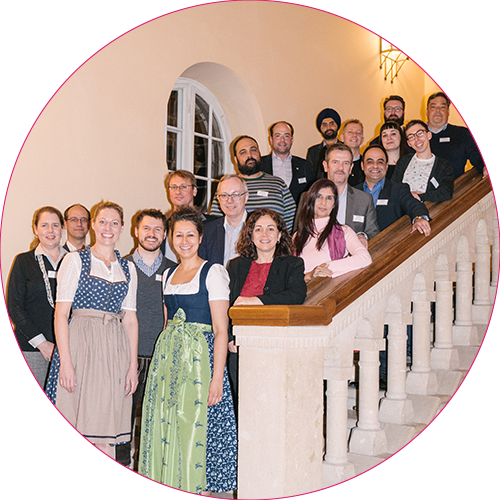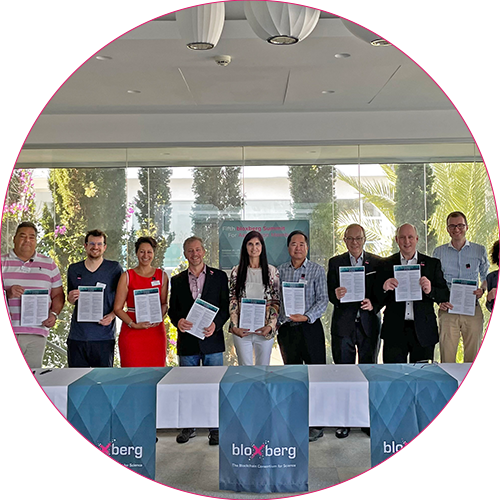Our Journey
Genesis: 2018 – 2019
bloxberg originated as a decentralized blockchain network to ensure the secure and verifiable time-stamping of research data. Scientific integrity depends on the ability to prove the authenticity and existence of data at a given time.
Recognizing the lack of an existing solution that met the specific needs of the scientific community — such as trust, continuity, performance, and independence from commercial interests — the Max Planck Digital Library (MPDL) took initiative. What began as a search for a timestamping service for researchers within the Max Planck Society quickly evolved into something much bigger.
In early 2019, the Max Planck Society brought together eleven research organizations from ten countries to co-found what would become the world’s first decentralized
 blockchain infrastructure built for science, by scientists. Each of these institutions shared a belief in the transformative potential of blockchain for research – not for speculation, but for verifiability, reputation, and scientific sovereignty.
blockchain infrastructure built for science, by scientists. Each of these institutions shared a belief in the transformative potential of blockchain for research – not for speculation, but for verifiability, reputation, and scientific sovereignty.
The story goes that after three days of intense, controversial, and constructive discussion — snowed in at Schloss Ringberg in the Bavarian Alps — the founders passed the bloxberg Whitepaper 1.0, defining both the technical specifications and the initial governance model of the network. This marked the official genesis of the bloxberg blockchain.
Later that year, bloxberg was officially recognized as a flagship project in the German Federal Government’s National Blockchain Strategy. The project was also invited to the Federal Round Table on Blockchain in Science & Research, representing the scientific perspective in shaping national infrastructure policy.
Founders:
The bloxberg initiative was shaped by a group of eleven founding research institutions and visionaries who foresaw the potential of blockchain in science. They laid the foundation for both the technical infrastructure and the original governance model in 2019.
The bloxberg Consortium: 2019 – 2022
From its launch, bloxberg operated as a global consortium of academic institutions. Using a Proof-of-Authority (PoA) consensus, each member ran a validator node – forming a trusted network designed specifically for scientific purposes.
This phase marked the rapid growth of the network, expanding from 11 to over 50 members and becoming the world’s largest academic blockchain validator network. Governance was exercised collectively, fostering decentralization and transparency across borders.
The bloxberg Association: 2022 – 2024
To provide bloxberg with a legal foundation and formal governance, the bloxberg Association for the Advancement of Science and Blockchain e.V. was established in 2022 as a registered non-profit organization in Germany. It introduced structured membership, democratic voting, and formal procedures for network participation.
However, as the network grew to over 55 institutional members globally and the underlying blockchain technology rapidly evolved, it became increasingly clear that a traditional association structure was too slow and rigid for the demands of a decentralized infrastructure still in early development. The pace and complexity of decisions in the blockchain space required more agile governance models.
In a constructive and forward-looking spirit, the members jointly decided not to fork or fragment the network. Instead, the bloxberg Association was formally dissolved in October 2024, while the strategic direction and operational responsibility for the bloxberg blockchain were returned to the Max Planck Society — its original initiator. The former association has since been renamed “Scientific Blockchain Alliance e.V.“, pursuing a new mission that is fully independent from the bloxberg blockchain infrastructure.
This step laid the foundation for bloxberg 2.0: a streamlined and modernized infrastructure strategy, preserving the scientific core of the network while opening the path toward progressive decentralization and technical renewal.
The bloxberg Council: 2025 – Present
Today, bloxberg is governed and maintained by the Max Planck Society, which now oversees its strategic, operational, and legal direction. The validator structure is being rebuilt through the formation of Data Availability Committees (DACs) – operated by academic institutions – ensuring that transaction data remains under scientific control.
The Validator Council represents the evolution of the original consortium: a focused, mission-driven group of institutions committed to advancing open, decentralized science on next-generation blockchain infrastructure.
Are you a research institution, a DAO, or a science-focused company interested in joining the Validator Council and operating a DAC? Get in touch – we’d love to hear from you.

